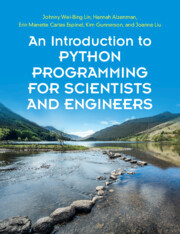
An Introduction to Python Programming for Scientists and Engineers
- Publisher's listprice GBP 57.00
-
27 231 Ft (25 935 Ft + 5% VAT)
The price is estimated because at the time of ordering we do not know what conversion rates will apply to HUF / product currency when the book arrives. In case HUF is weaker, the price increases slightly, in case HUF is stronger, the price goes lower slightly.
- Discount 10% (cc. 2 723 Ft off)
- Discounted price 24 509 Ft (23 342 Ft + 5% VAT)
Subcribe now and take benefit of a favourable price.
Subscribe
27 231 Ft

Availability
Estimated delivery time: In stock at the publisher, but not at Prospero's office. Delivery time approx. 3-5 weeks.
Not in stock at Prospero.
Why don't you give exact delivery time?
Delivery time is estimated on our previous experiences. We give estimations only, because we order from outside Hungary, and the delivery time mainly depends on how quickly the publisher supplies the book. Faster or slower deliveries both happen, but we do our best to supply as quickly as possible.
Product details:
- Publisher Cambridge University Press
- Date of Publication 7 July 2022
- ISBN 9781108701129
- Binding Paperback
- No. of pages766 pages
- Size 245x189x31 mm
- Weight 1610 g
- Language English 556
Categories
Short description:
Textbook that uses examples and Jupyter notebooks from across the sciences and engineering to teach Python programming.
MoreLong description:
Python is one of the most popular programming languages, widely used for data analysis and modelling, and is fast becoming the leading choice for scientists and engineers. Unlike other textbooks introducing Python, typically organised by language syntax, this book uses many examples from across Biology, Chemistry, Physics, Earth science, and Engineering to teach and motivate students in science and engineering. The text is organised by the tasks and workflows students undertake day-to-day, helping them see the connections between programming tools and their disciplines. The pace of study is carefully developed for complete beginners, and a spiral pedagogy is used so concepts are introduced across multiple chapters, allowing readers to engage with topics more than once. "Try This!" exercises and online Jupyter notebooks encourage students to test their new knowledge, and further develop their programming skills. Online solutions are available for instructors, alongside discipline-specific homework problems across the sciences and engineering.
'This book provides an excellent introduction to the Python language especially targeted at those interested in carrying out calculations in the physical sciences. I especially like the strong coverage of graphics and of good coding practice.' Raymond Pierrehumbert, University of Oxford
Table of Contents:
Part I. Getting Basic Tasks Done: 1. Prologue: Preparing to Program; 2. Python as a Basic Calculator; 3. Python as a Scientific Calculator; 4. Basic Line and Scatter Plots; 5. Customized Line and Scatter Plots; 6. Basic Diagnostic Data Analysis; 7. Two-Dimensional Diagnostic Data Analysis; 8. Basic Prognostic Modeling; 9. Reading In and Writing Out Text Data; 10. Managing Files, Directories, and Programs; Part II. Doing More Complex Tasks: 11. Segue: How to Write Programs; 12. n-Dimensional Diagnostic Data Analysis; 13. Basic Image Processing; 14. Contour Plots and Animation; 15. Handling Missing Data; Part III. Advanced Programming Concepts: 16. More Data and Execution Structures; 17. Classes and Inheritance; 18. More Ways of Storing Information in Files; 19. Basic Searching and Sorting; 20. Recursion; Part IV. Going From a Program Working to Working Well; 21. Make it Usable to Others: Documentation and Sphinx; 22. Make it Fast: Performance; 23. Make it Correct: Linting and Unit Testing; 24. Make it Manageable: Version Control and Build Management; 25. Make it Talk to Other Languages.
More



